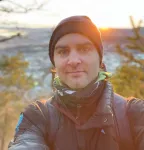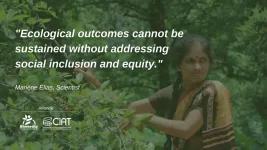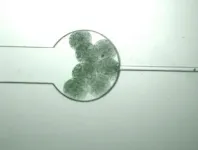Soot from heaters and traffic is not just a local problem
Study from Thuringia shows: 50% of the soot that is harmful to health comes from local sources and 50% from long-distance transport
2021-06-10
(Press-News.org) Leipzig. Soot particles from oil and wood heating systems as well as road traffic can pollute the air in Europe on a much larger scale than previously assumed. This is what researchers from the Leibniz Institute for Tropospheric Research (TROPOS) conclude from a measurement campaign in the Thuringian Forest in Germany. The evaluation of the sources showed that about half of the soot particles came from the surrounding area and the other half from long distances. From the researchers' point of view, this underlines the need to further reduce emissions of soot that is harmful to health and the climate, as the carbon-containing particles still contribute to health hazards and climate warming even over distances of several hundred kilometres.
The results were published in the journal Atmospheric Chemistry and Physics (ACP), an open access journal of the European Geosciences Union (EGU).
Aerosol particles in the atmosphere affect global climate, human health and ecosystems. The chemical composition of atmospheric particles at a given location depends not only on the local environment and sources, but is also influenced by the history of the particles reaching the sampling location. During transport, so-called ageing processes not only change the chemical composition of the particles, but also influence their physical properties (e.g. size distribution, volatility, hygroscopicity, cloud condensation nuclei (CCN) activity and optical properties). The load at a given location is therefore a complex mixture of different sources in combination with a complex transformation process. Carbonaceous aerosol particles predominate in the total mass of particles, consisting of a large number of chemical species and can be divided into organic aerosol (OA) and black carbon (BC). Black carbon is associated with primary emissions from combustion processes from anthropogenic sources (car, domestic heating and industry) or biogenic sources (e.g. forest fires). Not only local sources influence the chemical composition of aerosol particles. Long-distance transport also affects the chemical composition of aerosol particles through the origin of the air masses.
In September/October 2010, extensive measurements took place in Thuringia as part of the "Hill Cap Cloud Thuringia 2010" (HCCT-2010) experiment. The analysis now published examined the chemical composition of aerosol particles and the various sources of carbon-containing particles that reached the measurement site near the village of Goldlauter in the Thuringian Forest, Germany. At that time, a total of about 50 cloud researchers from Germany, France, England and the USA had participated in the measurements in the middle of Germany. The evaluation and chemical analysis of the extensive samples was very time-consuming and took several years. "The data analysis applied made it possible to distinguish local soot emissions dominated by fossil fuel combustion from soot transported from great distances," explains Dr Laurent Poulain from TROPOS. "But a physical effect also helped us: Over the course of their short lives, soot containing particles grow. The bigger this particle is, the older it is and the longer it must have been travelling in the atmosphere." The impactor samples were therefore divided into two categories: Carbon in particles smaller than 400 nanometres is relatively young and comes from local sources. Carbon in particles larger than 400 nanometres is relatively old and comes from distant sources. This allowed local soot emissions to be estimated at 48 per cent and soot from distant sources at 52 per cent.
In another study from winter 2016/17, TROPOS researchers were already able to estimate the share of transboundary particulate matter: Particulate matter of the PM10 size class from long-distance transport from Eastern Europe contributed 44 to 62 per cent of the total PM10 particulate matter at rural locations in Eastern Germany, according to a study for various state environmental offices. The main sources were combustion emissions, probably from wood and coal-fired heating systems. With the study now published, it is clear that even for soot, which accounts for only a portion of PM10 fine particulate matter, the relationship between ambient and remote sources is similar: about half of the soot comes from the local environment and the other half from long-distance transport across the continent.
The new findings underline the need to set Europe-wide limits for soot. In spring 2021, the EU Parliament called on the EU Commission to introduce EU-wide standards for ultrafine particulate matter, soot, mercury and ammonia, because although these substances have a negative impact on human health, they are not yet regulated by EU air quality standards. The EU Air Quality Directive is to be updated by 2022. A public consultation is planned for autumn 2021.
However, soot does not only have a negative impact on human health. It is becoming increasingly clear that soot also contributes to global warming by causing the dark particles to absorb light or contribute to cloud formation. According to the latest report of the Intergovernmental Panel on Climate Change (IPCC), there are still large gaps in our knowledge about the quantities and distribution of soot in the atmosphere, which the new report aims to reduce. The IPCC will adopt and publish its new assessment report ("AR6 Climate Change 2021: The Physical Science Basis") in early August 2021. Tilo Arnhold
INFORMATION:
Media contacts:
Dr Laurent Poulain
Scientific staff, Department Chemistry of the Atmosphere,
Leibniz Institute for Tropospheric Research (TROPOS)
Phone +49 341 2717-7316
https://www.tropos.de/en/institute/about-us/employees/laurent-poulain
and
Prof. Dr. Hartmut Herrmann
Head of the Atmospheric Chemistry Department,
Leibniz Institute for Tropospheric Research (TROPOS)
Phone +49 341 2717-7024
https://www.tropos.de/en/institute/about-us/employees/hartmut-herrmann
or
Tilo Arnhold
Public relations
Leibniz Institute for Tropospheric Research (TROPOS)
Phone +49-341-2717-7189
https://www.tropos.de/en/current-issues/press-releases
Links:
Campaign "Hill-Cap Cloud Thuringia (HCCT-2010)":
Cloud and precipitation chemistry and process studies
Soot:
Megacity traffic soot contributes to global warming (Press release, 13 Dec 2018)
Scientists and engineers will discuss at UN climate conference how the fight against air pollution can protect the climate (Press release, 30 Nov 2018)
EU Air Quality Directive:
Revision of the Ambient Air Quality Directives
IPCC Climate Report:
AR6 Climate Change 2021: The Physical Science Basis
(Publication planned for August 2021)
[Attachments] See images for this press release:

ELSE PRESS RELEASES FROM THIS DATE:
2021-06-10
It is generally agreed that sperms "swim" by beating or rotating their soft tails. However, a research team led by scientists from City University of Hong Kong (CityU) has discovered that ray sperms move by rotating both the tail and the head. The team further investigated the motion pattern and demonstrated it with a robot. Their study has expanded the knowledge on the microorganisms' motion and provided inspiration for robot engineering design.
The research is co-led by Dr Shen Yajing, Associate Professor from CityU's Department of Biomedical Engineering (BME), and Dr Shi Jiahai, Assistant Professor of the Department of Biomedical Sciences (BMS). Their findings have been published in ...
2021-06-10
An electrode coating just one molecule thick can significantly enhance the performance of an organic photovoltaic cell, KAUST researchers have found. The coating outperforms the leading material currently used for this task and may pave the way for improvements in other devices that rely on organic molecules, such as light-emitting diodes and photodetectors.
Unlike the most common photovoltaic cells that use crystalline silicon to harvest light, organic photovoltaic cells (OPVs) rely on a light-absorbing layer of carbon-based molecules. Although OPVs cannot yet rival the performance of silicon cells, they could be easier and cheaper to manufacture at a very large scale using ...
2021-06-10
The type of material present under glaciers has a big impact on how fast they slide towards the ocean. Scientists face a challenging task to acquire data of this under-ice landscape, let alone how to represent it accurately in models of future sea-level rise.
"Choosing the wrong equations for the under-ice landscape can have the same effect on the predicted contribution to sea-level rise as a warming of several degrees", says Henning Åkesson, who led a new published study on Petermann Glacier in Greenland.
Glaciers and ice sheets around the world currently lose more than 700,000 Olympic swimming pools of water every day. Glaciers form by the transformation of snow into ice, which is later melted by ...
2021-06-10
With the start of the United Nations' Decade on Ecosystem Restoration, which runs through 2030, a tremendous amount of money and effort will be put into re-growing forests, making over-exploited farmland productive, and reviving damaged marine environments. This is a good, and vital, initiative. Without quick action to clean up the fallout of humanity's scorched-earth economic systems, goals on hunger, biodiversity and climate will be unattainable.
But in examining restoration projects already underway across the globe, a group of scientists has found that restoration action is at risk of failure if it doesn't make ...
2021-06-10
Palaeoclimatologists study climate of the geological past. Using an innovative technique, new research by an international research team led by Niels de Winter (VUB-AMGC & Utrecht University) shows for the first time that dinosaurs had to deal with greater seasonal differences than previously thought.
De Winter: "We used to think that when the climate warmed like it did in the Cretaceous period, the time of the dinosaurs, the difference between the seasons would decrease, much like the present-day tropics experience less temperature difference between ...
2021-06-10
Inaccessible workplaces, normative departmental cultures and 'ableist' academic systems have all contributed to the continued underrepresentation and exclusion of disabled researchers in the Geosciences, according to an article published today (Thursday 8 June) in Nature Geosciences.
The article argues that changes to both working spaces and attitudes are urgently needed if institutions are to attract, safeguard and retain people with disabilities.
Anya Lawrence, a disabled early career researcher in the University of Birmingham's School of Geography, Earth and Environmental Science and author of the piece says:
"Disabled geoscientists like myself face barrier after barrier on a daily ...
2021-06-10
People who smoke, suffer from high blood pressure, obesity, or diabetes are not only at greater risk of suffering a stroke, heart attack, or dementia. For them, the risk of being affected by depressive mood or depression also increases. The more risk factors a person has, the more likely this is. Until now, however, it was unclear whether this probability also depends on their age. Earlier studies had already shown for other diseases such as dementia or stroke that a combination of several risk factors leads to a more frequent onset of the disease between the ages of 40 and 65 than in old age. Until now, however, it was unclear whether this also applies to depression.
Researchers ...
2021-06-10
MORGANTOWN, W. Va.-- Joining a club that sparks a new interest, playing a new intramural sport or finding a new group of friends may be just as indicative of a college freshman's loss of self-control as drinking or drug use, according to new research at West Virginia University.
Self-control--the ability to exercise personal restraint, inhibit impulsivity and make purposeful decisions--in that first year partly depends on a student's willingness to try new things, including things adults would call "good."
That's a new finding, according to Kristin Moilanen, associate professor of child development and family studies. The study, "Predictors of initial status and change in self-control during the college transition," observed 569 first year ...
2021-06-10
DURHAM, N.C. - Biomedical engineers at Duke University have demonstrated that a class of interwoven composite materials called semi-interpenetrating polymer networks (sIPNs) can be produced by living cells. The approach could make these versatile materials more biologically compatible for biomedical applications such as time-delayed drug delivery systems.
The research appears online on June 8 in the journal Nature Communications.
The concept of sIPNs has been around for more than 100 years and has been used in automotive parts, medical devices, molding compounds and engineering plastics. The general idea is for one or more polymers to assemble around another polymer scaffold in such a way that they become interlocked. Even though ...
2021-06-10
Humans expect that AI is Benevolent and trustworthy. A new study reveals that at the same time humans are unwilling to cooperate and compromise with machines. They even exploit them.
Picture yourself driving on a narrow road in the near future when suddenly another car emerges from a bend ahead. It is a self-driving car with no passengers inside. Will you push forth and assert your right of way, or give way to let it pass? At present, most of us behave kindly in such situations involving oth-er humans. Will we show that same kindness towards autonomous vehicles?
Using methods ...
LAST 30 PRESS RELEASES:
[Press-News.org] Soot from heaters and traffic is not just a local problem
Study from Thuringia shows: 50% of the soot that is harmful to health comes from local sources and 50% from long-distance transport





